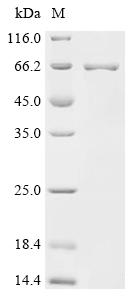Recombinant Human Interleukin-19 (IL19), Biotinylated, is expressed in E.coli and covers the complete mature protein spanning amino acids 25 to 177. The protein includes an N-terminal MBP-tag along with a C-terminal 6xHis-Avi-tag, which appears to make purification and detection more straightforward. SDS-PAGE analysis shows the protein reaches greater than 85% purity—a level that seems adequate for most research applications requiring high-quality recombinant proteins.
Interleukin-19 (IL19) represents a cytokine within the interleukin-10 family and is primarily involved in modulating immune responses. This protein plays what appears to be a critical role in signaling pathways that may influence various immune cell activities. Given its involvement in immune regulation, IL19 has drawn considerable interest from researchers studying inflammatory processes and immune-mediated conditions.
Potential Applications
Note: The applications listed below are based on what we know about this protein's biological functions, published research, and experience from experts in the field. However, we haven't fully tested all of these applications ourselves yet. We'd recommend running some preliminary tests first to make sure they work for your specific research goals.
Based on the provided information, the recombinant human IL19 is expressed in E. coli, a prokaryotic system that is generally unsuitable for producing functional eukaryotic cytokines like IL19. IL19 is a complex four-helix bundle cytokine that requires precise folding, proper disulfide bond formation, and dimerization for its biological activity through IL-20 receptor binding. While the protein is expressed as the mature form (25-177aa) with dual tags (N-terminal MBP and C-terminal 6xHis-Avi) and >85% purity, E. coli lacks the eukaryotic chaperones, disulfide isomerases, and quality control machinery necessary for correct folding of complex cytokines. The large MBP tag (maltose-binding protein, ~40 kDa) may significantly alter the protein's structure and interfere with its receptor-binding domains. Since activity is explicitly unverified, the protein cannot be assumed to be correctly folded or bioactive without experimental validation of its cytokine activity and receptor binding capability.
1. Antibody Development and Screening
The recombinant IL19 can serve as an effective immunogen for generating antibodies that recognize linear epitopes, even if the protein is misfolded. The dual tags facilitate purification and detection. However, antibodies may not recognize conformational or quaternary structure-dependent epitopes of native, properly folded IL19. Validation against IL19 from mammalian expression systems is essential.
2. Protein-Protein Interaction Studies
This application is high-risk without proper folding validation. While the tags enable technical feasibility for interaction studies, if IL19 is misfolded (as likely in E. coli with a large fusion tag), it will not interact physiologically with true receptors (IL-20R1/IL-20R2). Cytokine-receptor interactions require precise three-dimensional conformation. This application should not be pursued without confirmation of proper folding and receptor binding activity.
3. ELISA-Based Binding Assays
This application is problematic without activity verification. If IL19 is misfolded, ELISA binding assays will not reflect biological specificity. The assay may work for technical detection, but requires validation against properly folded IL19 for meaningful biological studies. The Avi tag enables biotinylation for streptavidin-based assays, but this doesn't compensate for potential folding issues.
4. Biochemical Characterization Studies
This application is well-suited for assessing the recombinant human IL19 itself. Techniques like size-exclusion chromatography with multi-angle light scattering, circular dichroism spectroscopy, and thermal shift assays can evaluate the protein's folding state, oligomerization, and stability. These studies are valuable for quality control, even if the protein is inactive.
Final Recommendation & Action Plan
Given the high probability of misfolding in E. coli for this complex cytokine with large fusion tags, recommend first performing comprehensive validation: 1) Biophysical characterization (analytical ultracentrifugation for oligomeric state, circular dichroism for secondary structure) to assess folding quality; 2) Functional validation using IL19-responsive cell assays (STAT activation in keratinocytes); 3) If possible, comparison with IL19 from mammalian expression systems. Antibody development can proceed as the safest application. Avoid all functional studies (interactions, binding assays) until proper folding and bioactivity are confirmed. For reliable IL19 research, obtain the protein from mammalian expression systems without large fusion tags. Always include appropriate controls, such as known active IL19 standards, in experiments.






